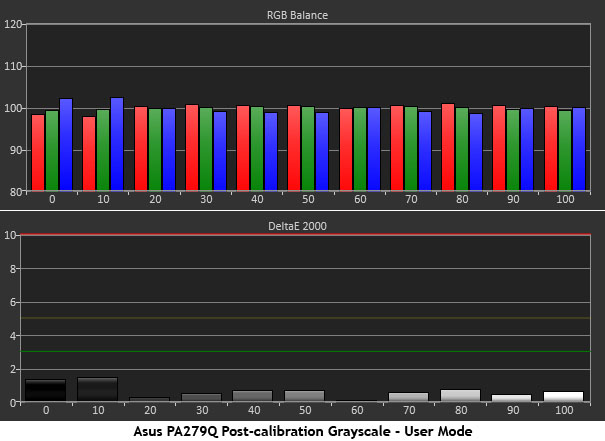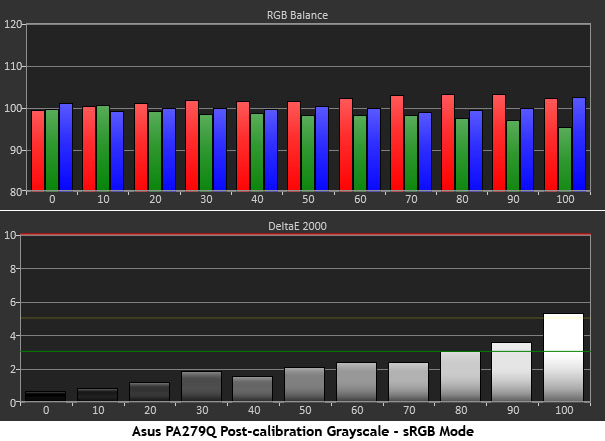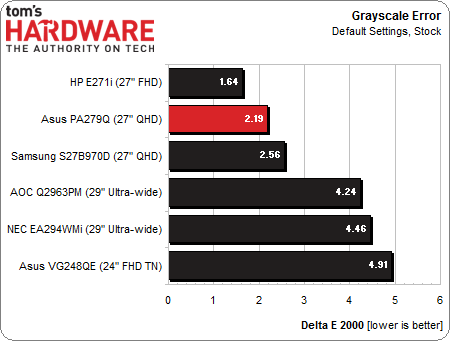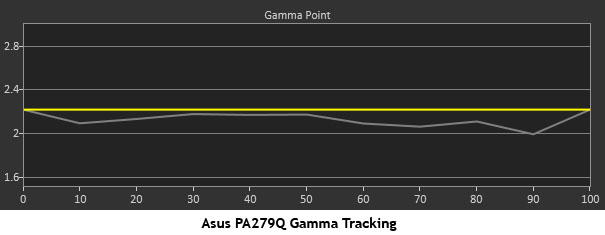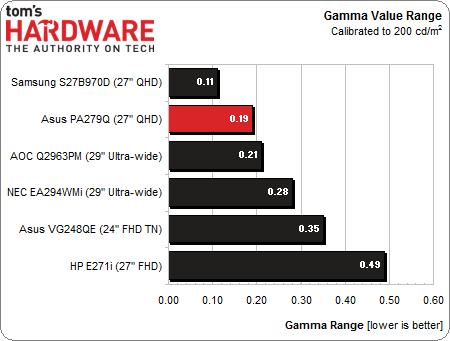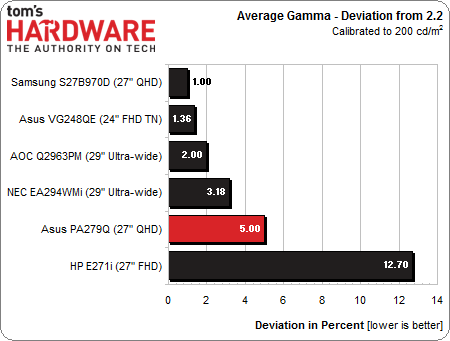Asus ProArt PQ279Q Monitor Review: 27-Inch, Wide-Gamut, QHD
Results: Grayscale Tracking And Gamma Response
The majority of monitors, especially newer models, display excellent grayscale tracking (even at stock settings). It’s important that the color of white be consistently neutral at all light levels from darkest to brightest. Grayscale performance impacts color accuracy with regard to the secondary colors: cyan, magenta, and yellow. Since computer monitors typically have no color or tint adjustment, accurate grayscale is key.
We approached the PA279Q a little differently than other screens we’ve reviewed due to its greater number of calibration options. Here is our baseline measurement of the Standard mode at default settings.
In Standard mode, you can adjust the color temperature preset, but not the RGB sliders. The default option is 6500 K. But as you can see, it runs a little too red. The error becomes visible at 40 percent brightness and above. Setting the PA279Q to the 9300 K option causes a slight blue tint to the white parts of the image.
There are two ways to improve the grayscale. One is to configure the User modes, which allow custom tailoring of both grayscale and color (though not without penalties, as you’ll see in the color section of the review). If you do that, you’ll be rewarded with excellent results.
It doesn’t really get better than this. Check out the 60-percent brightness level, which has a Delta E error of only .14! If you choose to use the like that, be sure to check out our color results on page seven first.
The compromise is to be found in the sRGB and Adobe RGB modes.
This is a pretty good chart, calibrated or not. Asus advertises a high degree of accuracy for the PA279Q and it certainly delivers on that promise. Visible errors don’t occur until 90 percent brightness, and then only barely. You get the exact same results in the Adobe RGB mode.
Get Tom's Hardware's best news and in-depth reviews, straight to your inbox.
Let’s bring our comparison group back into the mix. Since we chose sRGB as the best all-around picture mode, the numbers below represent that mode.
The stock number is quite good, bested only by HP's E271i. Even the factory-calibrated Samsung S27B970D isn’t quite as good, yielding a stock error of 2.56 Delta E. We’re picking nits, but the PA279Q does undercut that screen’s price by almost $300.
Since we couldn’t adjust grayscale in sRGB mode, the final number doesn’t change much.
The other displays rank higher by virtue of their available RGB adjustments. But the PA279Q still comes in well under the visible error level of three. If you employ User mode, you can get the average Delta E down to .71 which ties the Samsung for lowest grayscale error we’ve measured. It’s unfortunate that the color gamut is not as accurate in the User modes.
Gamma Response
Gamma is the measurement of luminance levels at every step in the brightness range from 0 to 100 percent. This is important because poor gamma can either crush detail at various points or wash it out, making the entire picture appear flat and dull. Correct gamma produces a more three-dimensional image, with a greater sense of depth and realism. Meanwhile, incorrect gamma can negatively affect image quality, even in monitors with high contrast ratios.
In the gamma charts below, the yellow line represents 2.2, which is the most widely accepted standard for television, film, and computer graphics production. The closer the white measurement trace comes to 2.2, the better.
Again, this is the sRGB mode. However, this gamma result is nearly identical to the Standard, User, and Adobe RGB modes. The tracking is fairly flat and rides just below 2.2. The maximum error here is less than 4 cd/m2.
Here’s our test group again for the gamma comparisons.
Asus' PA279Q is among the very best for gamma tracking. This level of consistency is only present in three other monitors we’ve tested this year. The S27B970D is exceptional, and Asus trails it by only a tiny bit.
We calculate gamma deviation by simply expressing the difference from 2.2 as a percentage.
The five-percent deviation from 2.2 is fairly small, representing no more than 4 cd/m2. Again, the PA279Q is among the best screens we’ve measured for gamma performance.
Current page: Results: Grayscale Tracking And Gamma Response
Prev Page Results: Brightness And Contrast Next Page Results: Color Gamut And Performance
Christian Eberle is a Contributing Editor for Tom's Hardware US. He's a veteran reviewer of A/V equipment, specializing in monitors. Christian began his obsession with tech when he built his first PC in 1991, a 286 running DOS 3.0 at a blazing 12MHz. In 2006, he undertook training from the Imaging Science Foundation in video calibration and testing and thus started a passion for precise imaging that persists to this day. He is also a professional musician with a degree from the New England Conservatory as a classical bassoonist which he used to good effect as a performer with the West Point Army Band from 1987 to 2013. He enjoys watching movies and listening to high-end audio in his custom-built home theater and can be seen riding trails near his home on a race-ready ICE VTX recumbent trike. Christian enjoys the endless summer in Florida where he lives with his wife and Chihuahua and plays with orchestras around the state.
-
Sid Jeong I think it's gonna be a hit with small studios and many freelance designers. I'd consider it when I upgrade my monitor in the future.Reply -
zentrope People who cannot buy Eizo,Nec,Lacie...Reply
And are not happy with Dell and HP...
You should be smiling now!
Also at some places you can even get this around $800.. -
slomo4sho It appears that my three Asus VS238H-P which cost me $360 total are going have a fairly long life span since 1440P still demands a hefty premium over quality 1080P displays. Hopefully we get some quality 4k displays for around 1k soon, the ASUS PQ321Q needs some competition :)Reply -
amgsoft What is the actual reason for calibrating at 200 cd/m2. The usual standard calibration is 120 cd/m2 at 6500K, see http://en.wikipedia.org/wiki/Color_calibration.Reply -
JeanLuc The same panel can be found in Korean import models such as the Achieva Shimian QH2700-IPSMS which is roughly half the price. I would love to see Toms benchmark these premium panels against the cheap imports.Reply -
JackNaylorPE Almost perfect ....When it comes in 144hz or greater, call me .Reply
Liking the new Eizo model w/ 240 Hz mode too. -
lhughey I want a QHD monitor, but I can't afford a gaming card that will work well with that resolution just yet. Maybe in a six months when Nvidia drops its Maxwell cards.Reply -
Nintendo Maniac 64 Am I the only one that wants to know about upscaling quality? Last time I checked most monitors upscale pretty badly, and considering that this has an HDMI input I don't think it'd be unthinkable to have a 720p or a 1080p external video source.Reply -
Bondfc11 Why doesn't Tom's do the Overlord Tempest 2560x1440 IPS that will overclock refresh rates up to 120Hz? they are sellign for like $500 now and are killer!Reply

